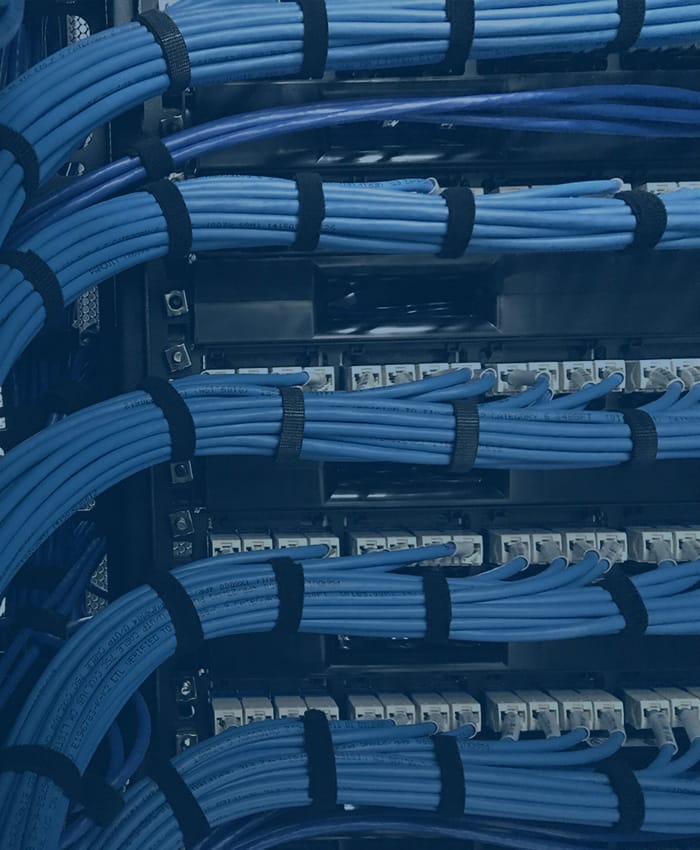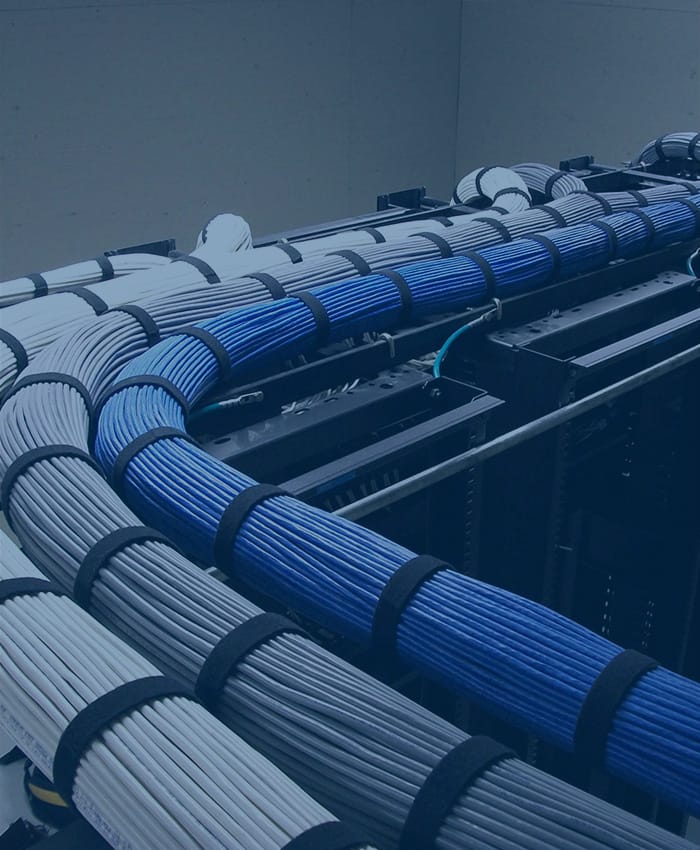Structured Network Cabling
The Backbone of Your Business Connectivity!
In today's fast-paced, tech-driven world, a reliable and scalable network is crucial for business success. Structured network cabling provides the foundation for seamless communication, data transfer, and efficient business operations.
Request a FREE Quote!Call now:(760) 300-3260

Structured Network Cabling Installation Services
Structured Network Cabling is the foundation of a well-organized, efficient, and scalable network infrastructure for businesses. It provides seamless connectivity for voice, data, and multimedia systems, while ensuring flexibility for future growth. Designed to minimize downtime, enhance performance, and support modern technology, structured cabling is a cost-effective solution that keeps your business connected and ready for the future.
- Seamless Connectivity:
In an era where digital transformation is key, businesses rely on fast and uninterrupted connectivity. Structured network cabling provides the foundation for a unified and efficient communication system. Whether it's handling high-speed internet, data sharing, or VoIP services, structured cabling keeps your network running smoothly, allowing your business to focus on what matters most growth and innovation. - Scalable Infrastructure:
As your business grows, so does the demand on your network. One of the main advantages of structured cabling is its scalability. It’s designed to handle the addition of new devices, workstations, or even entire departments with minimal disruption. This future-proof system ensures your network infrastructure can expand alongside your business without requiring a complete overhaul. - Minimize Downtime, Maximize Efficiency:
Disorganized cabling can lead to network issues and downtime, which costs your business time and money. Structured cabling eliminates this risk by organizing your network into a logical, easy to manage system. This approach allows for quick troubleshooting, faster repairs, and enhanced reliability ensuring your operations stay productive and connected. - Long-Lasting Solutions:
With structured cabling, you make an investment in the long-term efficiency and performance of your network. While the initial setup is cost-effective, the benefits multiply over time as it reduces maintenance costs and minimizes the need for frequent updates. Structured cabling is designed to last, offering a reliable infrastructure that supports your business for years to come. - Business Technology:
Technology is constantly evolving, and your network should be able to adapt without disruption. Structured cabling is flexible and future-proof, meaning it’s ready to support the latest advancements in technology—whether it’s integrating new smart systems, upgrading to faster data speeds, or expanding bandwidth. Your network will stay ahead of the curve.
The Benefits of Structured Network Cabling
The Benefits of Structured Cabling include enhanced network performance, simplified maintenance, and scalability for future growth. This organized system reduces downtime, improves efficiency, and supports new technologies as they emerge. Structured cabling provides a cost-effective, long-term solution that keeps your business connected and ready for expansion.
- Enhanced Performance and Reliability:
Structured cabling systems are designed to optimize network performance. By organizing cables and connections, they reduce signal interference and ensure faster data transfer rates. This reliability translates to fewer disruptions, allowing your team to work efficiently without interruptions. - Scalability for Future Growth:
One of the standout features of structured cabling is its scalability. As your business expands, adding new devices or systems is seamless and hassle-free. This adaptability ensures your network can grow alongside your business, accommodating future needs without costly upgrades. - Simplified Maintenance and Troubleshooting:
A well-organized cabling system makes maintenance straightforward. With structured cabling, identifying and resolving issues becomes quicker and easier, minimizing downtime. This efficiency not only saves time but also reduces the costs associated with repairs and maintenance. - Cost-Effective Solution:
Investing in structured cabling is a smart financial decision. While the initial setup may require an investment, the long-term savings in maintenance, energy efficiency, and increased productivity far outweigh the costs. This cost-effective approach ensures your network infrastructure remains robust for years to come. - Future-Proof Technology Integration:
As technology evolves, your network must adapt. Structured cabling is built to support a wide range of applications, from high-speed internet to cloud computing and IoT devices. This flexibility ensures that your infrastructure can handle the latest technologies, keeping your business competitive and agile.


Why Choose Network Cabling for Structured Cabling Solutions
Choose Network Cabling for expert, tailored structured cabling solutions that ensure reliable, high-performance connectivity. With years of industry experience, we deliver customized systems designed for your business's growth and technology needs. Our commitment to quality, efficient installations, and ongoing support makes us the trusted partner to keep your network running smoothly.
- Expertise You Can Trust:
At Network Cabling, we bring years of experience and industry knowledge to every project. Our team of certified professionals understands the intricacies of structured cabling and ensures that each installation is tailored to meet the unique needs of your business. With a proven track record of delivering reliable solutions, you can trust us to get the job done right the first time. - Customized Solutions for Your Business:
No two businesses are the same, which is why we don’t offer one size fits all solutions. Our team takes the time to understand your current infrastructure and future goals, designing a structured cabling system that fits your exact requirements. Whether you're upgrading an existing network or building a new one from the ground up, we create flexible, scalable solutions tailored just for you. - Commitment to Quality and Performance:
We pride ourselves on using top-quality materials and state of the art technology to ensure long-lasting performance. From high grade cables to advanced testing tools, we guarantee that your network cabling system will meet industry standards and perform optimally under any conditions. Our commitment to quality ensures your business enjoys reliable, high-speed connectivity for years to come. - Timely and Efficient Installations:
We know that downtime can cost your business money, which is why our team is committed to completing installations quickly and efficiently. Our streamlined process minimizes disruption to your operations, ensuring your network is up and running without unnecessary delays. We work on your schedule, providing professional service that meets your timeline. - Ongoing Support and Maintenance:
Our relationship doesn’t end once your cabling system is installed. Network Cabling offers ongoing support and maintenance services to ensure your network continues to operate at peak performance. Whether you need troubleshooting, upgrades, or future expansions, our team is always ready to help keep your business connected.
Structured Network Cabling Installation
No matter the industry, Structured Network Cabling Service provides tailored solutions to meet the unique needs of each business, ensuring reliable and high-performance network connectivity.
- Corporate Offices
For seamless connectivity and support for large volumes of data transfer. - Healthcare Facilities
Ensures reliable communication for patient data, telemedicine, and medical devices. - Educational Institutions
Supports digital learning, high-speed internet, and inter-departmental communication. - Manufacturing and Industrial
Provides reliable connectivity for IoT devices, automation systems, and operational efficiency. - inancial Services
Enables secure data transmission, VoIP, and fast transaction processing. - Retail and E-commerce
Supports point-of-sale systems, inventory management, and customer Wi-Fi. - Hospitality and Hotels
For guest Wi-Fi, security systems, and centralized communication. - Data Centers
Organizes high-density cabling for efficient server and data management. - Government and Municipal Buildings
Enables secure, organized connectivity for critical public services. - Telecommunications
Supports network infrastructure for phone systems, internet, and multimedia.


- Real Estate and Property Management
Provides reliable networks for surveillance, intercoms, and office connectivity. - Research and Development
For high-speed data transfer, secure storage, and cross-department collaboration. - Logistics and Transportation
Supports tracking systems, communication, and warehouse management. - Media and Entertainment
Handles large files, streaming, and multimedia production. - Legal Services
Provides secure connectivity for handling confidential client data and video conferencing. - Call Centers
Ensures stable VoIP and high-volume data transfer for customer interactions. - Energy and Utilities
For monitoring, remote access, and seamless communication in distributed facilities. - Pharmaceuticals and Biotech
Supports R and D, secure data storage, and communication within facilities. - Construction Companies
Facilitates mobile offices, project management, and communication on job sites. - Non-Profit Organizations
Provides reliable infrastructure to handle data and communication needs effectively.
Structured Network Cabling FAQs
Structured Network Cabling FAQs provide answers to common questions about the benefits, installation, and functionality of structured cabling systems. Whether you're looking to understand how it improves network performance, supports future technology, or how it can benefit your business.
What is structured network cabling?
Structured network cabling is an organized system of cables and related hardware that supports the infrastructure for a business’s network. It enables seamless communication, data transfer, and internet connectivity for various devices such as computers, phones, and security systems.
What are the key components of structured cabling?
The key components include cables (like Cat5e, Cat6, fiber optics), patch panels, network switches, and racks. These components are organized to create a robust, efficient network infrastructure.
How is structured cabling different from traditional cabling?
Unlike traditional point-to-point cabling, structured cabling uses an organized system that allows for easier management, scalability, and future growth. It reduces clutter, simplifies troubleshooting, and improves overall network performance.
What industries benefit from structured network cabling?
Industries such as healthcare, education, finance, manufacturing, and retail benefit from structured cabling as it supports large data volumes, secure communication, and future technological advancements.
How does structured cabling improve network performance?
By organizing cables systematically, structured cabling reduces interference, increases data transfer speeds, and ensures consistent, reliable connectivity across all devices and systems within the network.
Can structured cabling support future technology?
Yes, structured cabling is designed to be flexible and scalable, allowing it to support future technology upgrades, including higher data speeds, new devices, and enhanced security systems.
How long does structured cabling last?
With proper installation and quality materials, structured cabling systems typically last 10-15 years or more. Regular maintenance and upgrades can extend the system’s lifespan.
Is structured cabling suitable for small businesses?
Absolutely. Structured cabling is beneficial for businesses of all sizes as it offers scalability and flexibility, allowing small businesses to grow without overhauling their entire network infrastructure.
What type of cabling is typically used in structured cabling systems?
Common types of cabling include Cat5e, Cat6, Cat6a, and fiber optic cables. The choice depends on the business’s bandwidth requirements and future expansion plans.
What is the difference between Cat5e, Cat6, and fiber optic cables?
Cat5e and Cat6 cables are twisted-pair copper cables used for standard Ethernet networks, with Cat6 supporting higher speeds. Fiber optic cables transmit data as light, offering faster speeds, greater bandwidth, and longer transmission distances.
How does structured cabling reduce downtime?
By organizing cables into a logical structure, issues such as faults or disconnections are easier to identify and fix, reducing downtime. Structured cabling also minimizes clutter, decreasing the chance of accidental disconnections.
How much does structured cabling cost?
The cost varies depending on the size of the installation, the type of cables used, and the complexity of the network. However, structured cabling is considered a long-term investment that reduces operational costs over time.
Can structured cabling systems be upgraded?
Yes, structured cabling is highly flexible and can be upgraded as your business grows or as new technology becomes available. This makes it a future-proof solution for businesses.
How long does it take to install structured cabling?
The installation time depends on the size of the facility and the complexity of the cabling needs. Smaller installations may take a few days, while larger projects could take weeks. A professional installer will provide a detailed timeline.
What is the role of a patch panel in structured cabling?
A patch panel serves as a central hub where cables are connected. It helps manage and organize connections, allowing for easy rerouting and troubleshooting of network issues.
What are the maintenance requirements for structured cabling?
Structured cabling requires minimal maintenance. Regular inspections to check for wear and tear, proper labeling, and cable management help keep the system running efficiently. Any damaged cables should be replaced promptly.
How does structured cabling support VoIP systems?
Structured cabling enables Voice over IP (VoIP) systems by providing a high-performance, reliable network infrastructure that supports voice and data transmission over the same system, enhancing communication capabilities.
Can structured cabling support wireless networks?
Yes, structured cabling is the backbone of wireless networks. It connects wireless access points to the network, ensuring strong, reliable Wi-Fi coverage throughout a business facility.
What are the environmental considerations for structured cabling?
When installing structured cabling, factors like temperature, humidity, and electromagnetic interference must be considered. Quality cabling materials and proper installation techniques help mitigate environmental risks.
Why should I hire a professional for structured cabling installation?
A professional installer ensures the cabling is designed and installed correctly for maximum performance, scalability, and reliability. They follow industry standards and provide ongoing support to maintain network efficiency.
